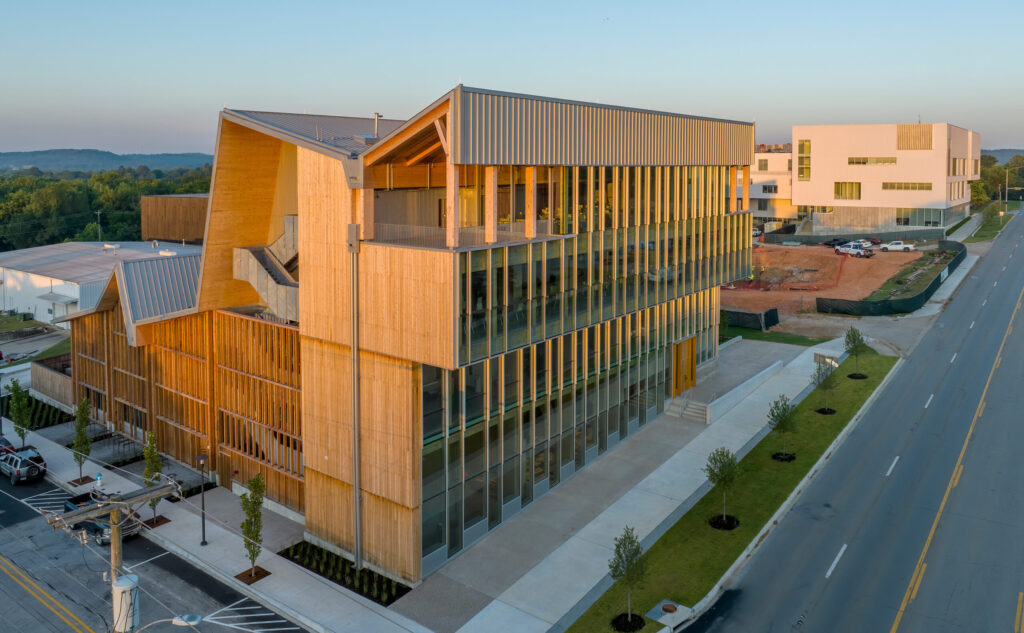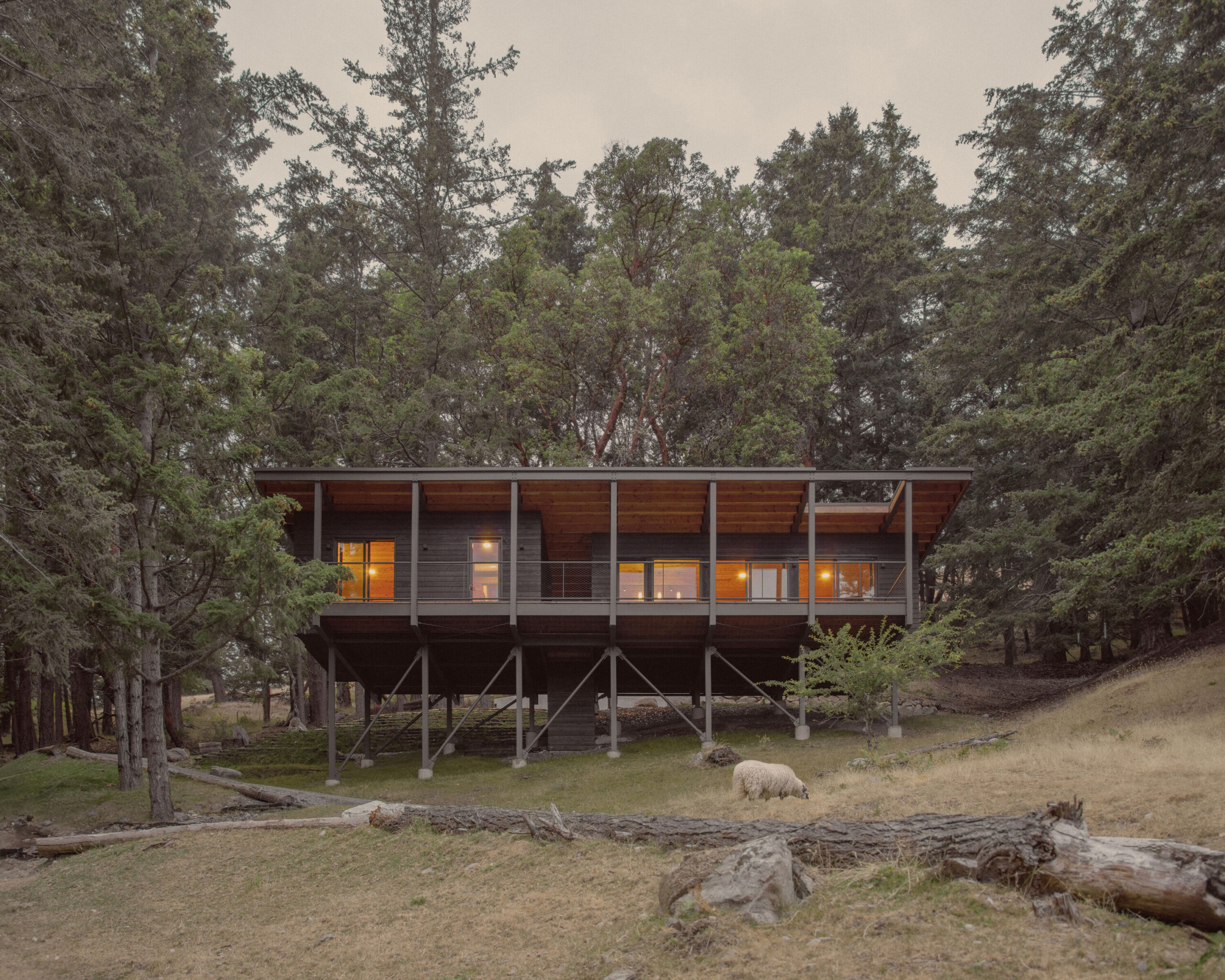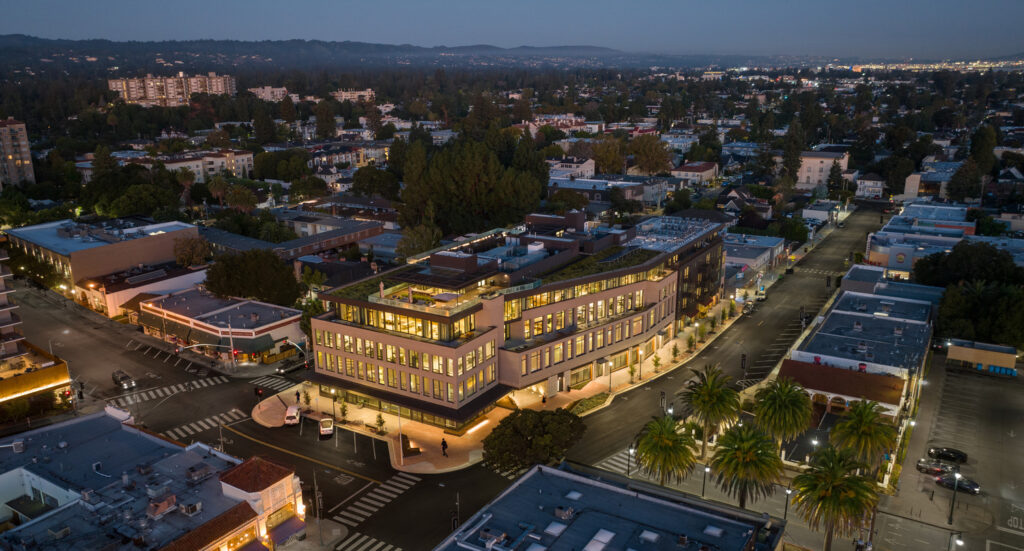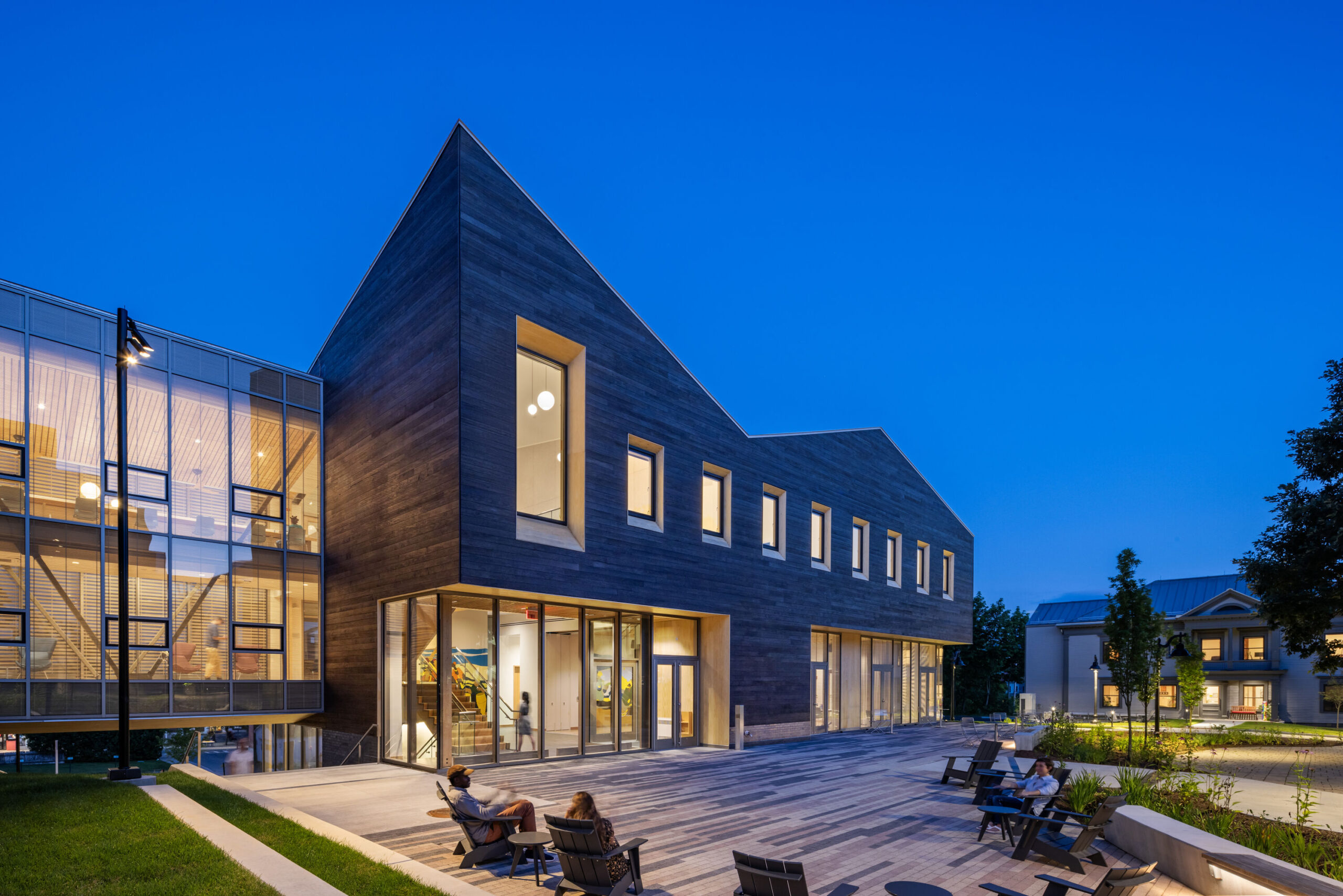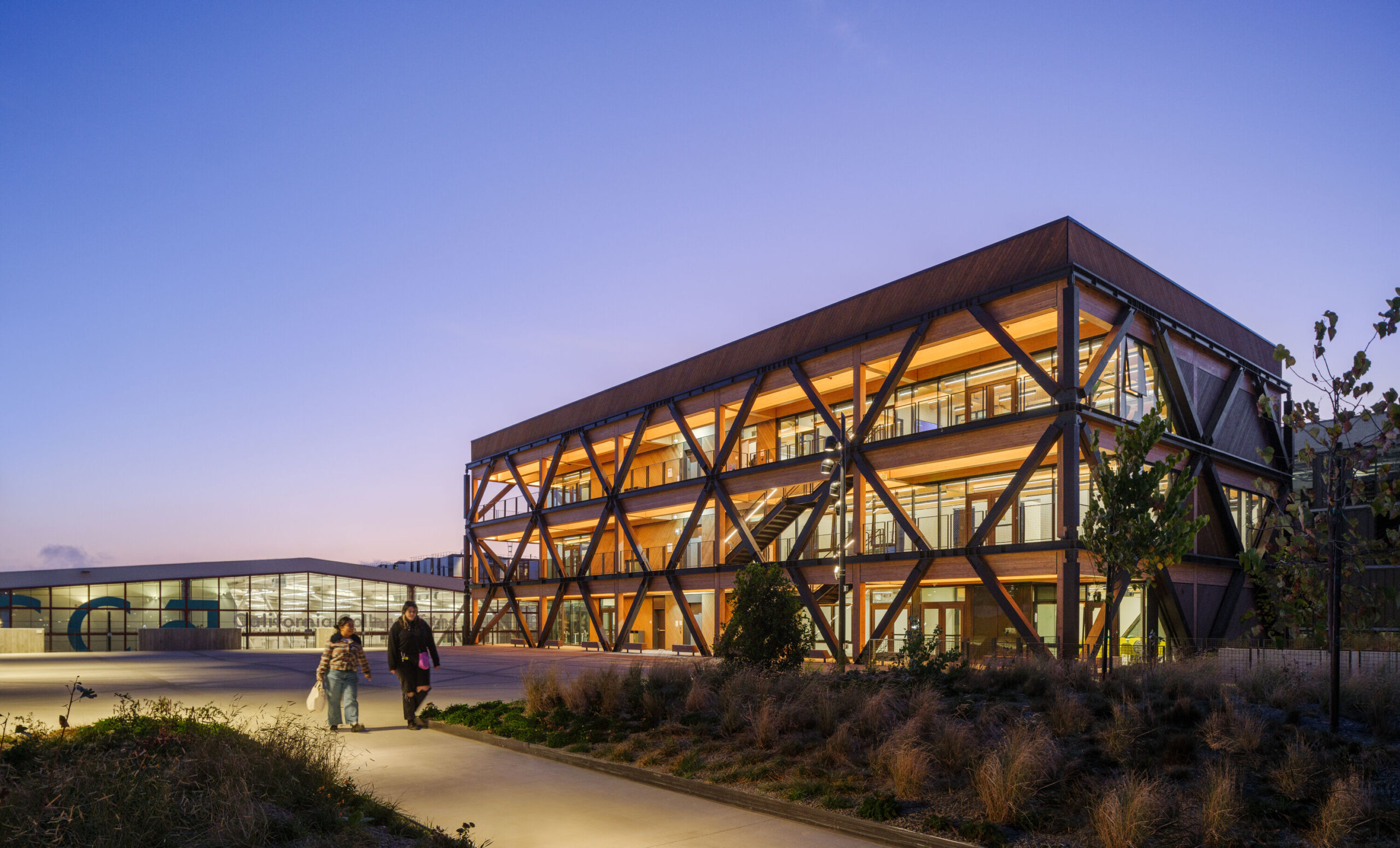Education, Light-Frame Construction, Mass Timber
Timber Tutelage at The Ecology School
Historic vernacular light-frame meets modern mass timber in this super-sustainable, nearly all-wood prefabricated New England ecological educational center dedicated to hands-on learning.
Ecology School | Dormitories
The Ecology School is a nonprofit environmental education program focused on hands-on, experiential learning for both children and adults—as well as teachers and educators. Onsite forests, river ecosystems, and an organic farm serve as an outdoor classroom, complemented by indoor learning spaces that showcase the school’s commitment to sustainable living.
Situated on 109 acres of farmland on the Saco River in Southern Maine, the school’s new campus is a modern take on the region’s historic saltbox structures, adding three interconnected dormitory wings and a new dining and learning commons to an existing farmhouse on site. But beneath those simple silhouettes is an ultra sustainable prefab wood design that cuts carbon and boasts net-positive energy and water consumption, all part of the first master plan in the world to meet the rigorous International Living Future Institute’s Living Community Challenge (LCC).

Ecology School
The Future of Sustainable,
Prefabricated Construction
“In decades past, high-tech was associated with shiny steel, concrete and glass,” says Jesse Thompson, a principal at Kaplan Thompson Architects, one of three local firms contributing to the project. “But today we see wood construction as the new high-tech and the future of sustainable prefabricated construction systems—with a growing list of good reasons why.”
Carbon savings, thermal advantages, faster airtight construction, and biophilic benefits were at the top of that list for The Ecology School. The non-profit, which was started in 1998 and runs a “learn what you live” curriculum focused on understanding and caring for the environment, wanted its new campus to be an exemplar of sustainable eco-friendly design.

Ecology School
Prefabricated light-frame and mass timber construction reduced The Ecology School’s embodied carbon and, through local sourcing, further cut emissions associated with long-distance shipping and delivery. Designed to Passive House standards, the robust panelized wall assemblies combine wood’s naturally insulating qualities with a high-performance, airtight, well-insulated prefab system—a plus during Maine’s colder months. As a result, the energy consumption of the dormitories alone is equal to that of the dining common’s industrial dishwasher.
The project was also a boon for greening the local economy—all materials used in the project are free of the Living Building Challenge’s (LBC) Red List chemicals, many of them sourced from local, responsibly managed companies. The lumber and glulam used in the project came from nearby wood fabricators, including 5,000 square feet of Maine white pine siding.

Ecology School | Dormitories
Timber Trio: Three Firms Work as One
Thompson’s firm was just one of three Maine-based design firms that worked on the project together—an unusual arrangement requested by client and school co-founder Drew Dumsch, who felt diversity of perspectives in the project team would give the campus a more rounded design.
While at first skeptical, all three firms signed on—and the project’s success exceeded their expectations. “It was really bringing to the table an ecological view to solving a design problem,” Thompson says. “If biodiversity in nature is good, then maybe diversity of design is good, too.”
Scott Simons Architects was selected to design the 7,000-square-foot dining and learning commons to support up to 200 guests for meals, meetings, and educational activities; Briburn for the 9,000-square-foot, 144-bed interconnected dormitories; and Kaplan Thompson Architects to offer ongoing design oversight and manage the material selections that were so critical to meeting the International Living Future Institute’s rigorous certification standards for both its LBC, for the school’s buildings, and LCC for the school’s master plan.

Ecology School | Dormitories
Separate from the design team’s scope, the school also has a 20-person meeting room in an existing former farmhouse located on the site, along with four yurts for additional programming and educational space. Additional dormitories are planned, and the farmhouse is scheduled for a major retrofit to boost its energy efficiency.
“We decided to lean into our best assets and, in many ways, we acted as one firm,” says Chris Briley, principal architect at Briburn. “We all put our egos aside and worked very collaboratively to complete the initial master planning together. It wasn’t until later, when it was time to really start designing the buildings, that we divided up the workload.”
The teamwork paid off in a cohesive design solution despite the three firms’ diverse perspectives, says Ryan Kanteres, principal architect at Scott Simons Architects: “The master plan, New England saltbox configuration, and the materiality, particularly the use of wood on the project, are strong unifying factors—and it’s also a local success story, as the project spurred local lumber suppliers to meet the LBC requirements for certified wood products, in turn increasing the overall supply for future projects.”

Ecology School | Commons

Ecology School | Commons
Eco-Friendly Wood Design Teaches Sustainable Living
The Ecology School’s advanced sustainability showcases its commitment to ecologically sound development—and as Thompson and his collaborators point out, provides a direct case study for students and faculty alike in how to reduce our impact on sensitive ecosystems.
Materials on the LBC Red List are banned altogether because of their carbon footprint or environmentally destructive manufacturing processes. This includes vinyl siding, expanded polystyrene (rigid foam insulation panels), certain chrome finishes, and polyvinyl chloride plumbing pipes, to name a few.
“People have no idea how many parts are in their building. We never knew, until this,” Thompson says. “Now we have the spreadsheets.”
The project’s use of wood played an important part in achieving the LBC standard, with only two dozen projects in the world achieving full certification.
In many ways the International Living Future Institute (ILFI) advocates for a return to natural materials, like wood, Thompson explains. “To achieve this standard, we used local wood and cellulose insulation, and stayed away from concrete, steel, plastics and spray foam,” he adds. The ILFI is the non-profit that created and manages LBC, LCC, and other certification programs.

Ecology School | Commons
To fully meet its ILFI certification, the project must carefully monitor energy consumption, water consumption, occupant feedback, and also conduct a full life-cycle assessment—work that is currently underway.
The nearly all-wood campus also minimizes its ecological impact by keeping its footprint to less than nine acres—a small percentage of the total site. The new dining and learning commons includes an all-electric commercial kitchen. The trio of interconnected dormitories include simple steel-framed bunk beds and small alcove shelving to economically accommodate overnight guests with just enough room for a basic wood-framed desk and chair for quiet study. Elevated wood walkways further reduce any impacts to the natural environment.
All the campus buildings feature prefabricated light-frame wood construction, with the dining and learning commons achieving its column-free design with glulam beams that also support 200 rooftop solar panels. Local supplier Hancock Lumber prefabricated the dorm’s roof trusses and wooden wall panels for both buildings. Panelized components were complemented by onsite light-frame construction.
“This prefab approach, and having much of the framing done offsite, was incredibly effective, speeding up construction and reducing the onsite crew size—and it helped us contend with labor shortages during the pandemic,” Briley says.
Within the light-filled commons, the exposed black spruce glulam beams—which shipped prefabricated and ready-to-assemble—offer a sense of contemporary warmth, while affording an open flexible space for a variety of table configurations and versatile seating arrangements as needed. From inside the dining and learning commons, visitors can step out onto a deep south-facing wood porch covered by a catslide roof, to take in views of the school’s lush, ecologically protected landscape—making the surrounding ecosystems as much a part of the classroom as the building itself.

Ecology School | Commons
“We incorporated a modern interpretation of a farmer’s porch—it becomes the interstitial space between the inside and the outside for the whole site,” Kanteres says. “We really wanted to connect occupants to the outdoors and bring the outdoors inside for the students. That was a real design driver throughout the project.”
It’s a design that immerses students in the site’s rich and diverse ecosystems—and delivers an enchanting educational experience that couldn’t be more timely as generations, old and new, tackle some of the biggest climate challenges of our times.
“The project shows that wood has an important role to play in advanced sustainable buildings,” Kanteres says. “It may not look like The Jetsons, that Space Age idea of high-tech. Instead, we’re discretely incorporating state-of-the-art systems while finding inspiration in biophilic design, relationship to place, and nature itself.”

Ecology School | Commons
Project Details
- Project Name:
- Location:
- Saco, ME
- Architect:
- Structural Engineer:
- Contractor:
- Type:
- Timber Products:


